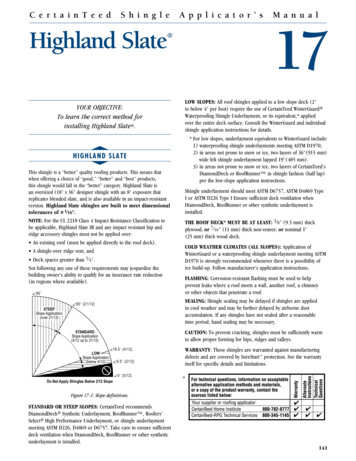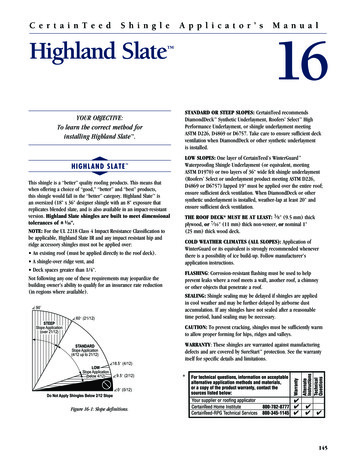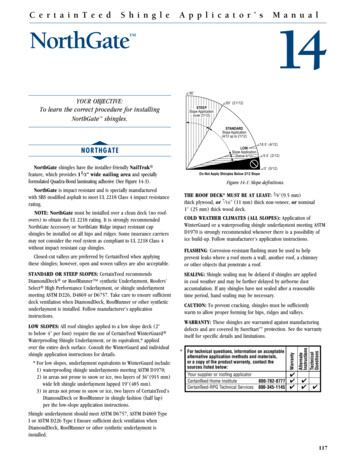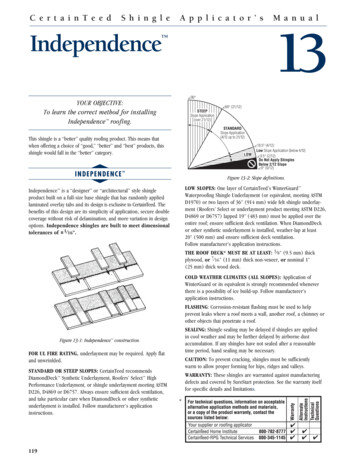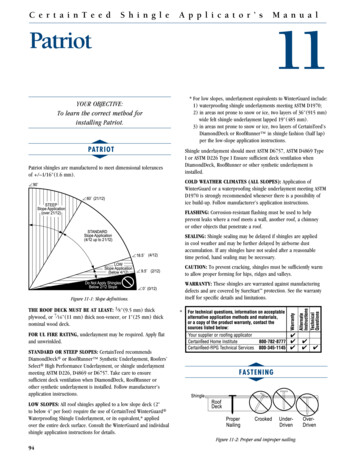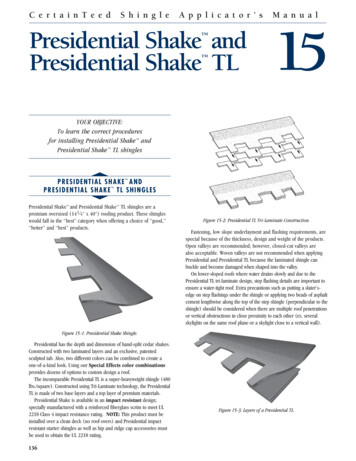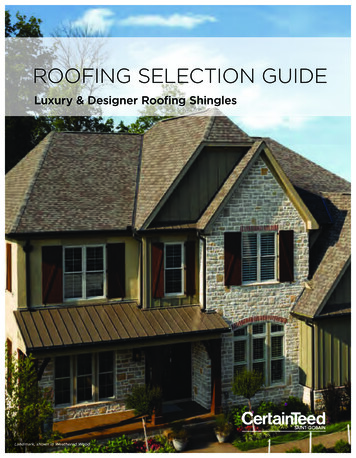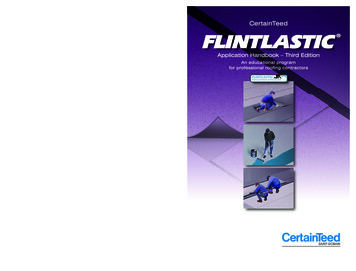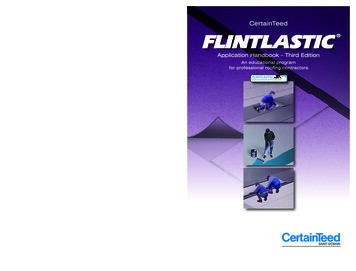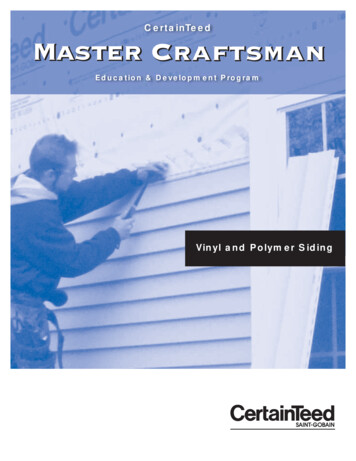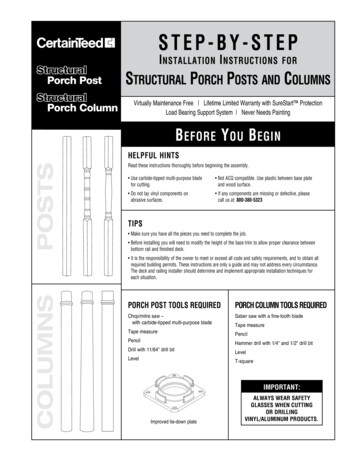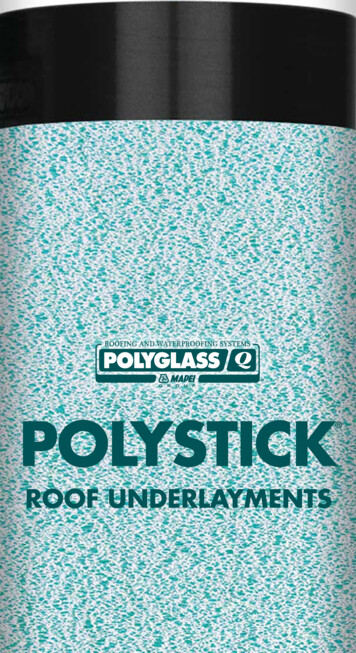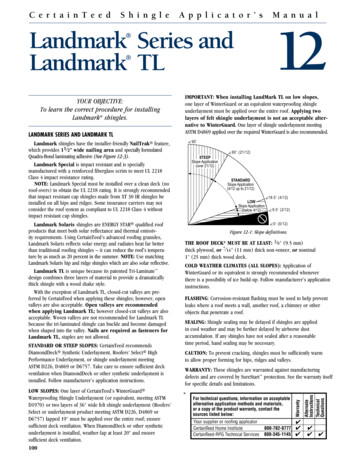
Transcription
S h i n g l eA p p l i c a t o r ’ sM a n u a l12Landmark Series andLandmark TL LANDMARK SERIES AND LANDMARK TLIMPORTANT: When installing LandMark TL on low slopes,one layer of WinterGuard or an equivalent waterproofing shingleunderlayment must be applied over the entire roof. Applying twolayers of felt shingle underlayment is not an acceptable alternative to WinterGuard. One layer of shingle underlayment meetingASTM D4869 applied over the required WinterGuard is also recommended.90 Landmark shingles have the installer-friendly NailTrak feature,which provides 11 2 " wide nailing area and specially formulatedQuadra-Bond laminating adhesive (See Figure 12-3).Landmark Special is impact resistant and is speciallymanufactured with a reinforced fiberglass scrim to meet UL 2218Class 4 impact resistance rating.NOTE: Landmark Special must be installed over a clean deck (noroof-overs) to obtain the UL 2218 rating. It is strongly recommendedthat impact resistant cap shingles made from XT 30 IR shingles beinstalled on all hips and ridges. Some insurance carriers may notconsider the roof system as compliant to UL 2218 Class 4 withoutimpact resistant cap shingles.Landmark Solaris shingles are ENERGY STAR qualified roofproducts that meet both solar reflectance and thermal emissivity requirements. Using CertainTeed’s advanced roofing granules,Landmark Solaris reflects solar energy and radiates heat far betterthan traditional roofing shingles – it can reduce the roof’s temperature by as much as 20 percent in the summer. NOTE: Use matchingLandmark Solaris hip and ridge shingles which are also solar reflective.Landmark TL is unique because its patented Tri-Laminate design combines three layers of material to provide a dramaticallythick shingle with a wood shake style.With the exception of Landmark TL, closed-cut valleys are preferred by CertainTeed when applying these shingles; however, openvalleys are also acceptable. Open valleys are recommendedwhen applying Landmark TL; however closed-cut valleys are alsoacceptable. Woven valleys are not recommended for Landmark TLbecause the tri-laminated shingle can buckle and become damagedwhen shaped into the valley. Nails are required as fasteners forLandmark TL, staples are not allowed.STANDARD OR STEEP SLOPES: CertainTeed recommendsDiamondDeck Synthetic Underlayment, Roofers’ Select HighPerformance Underlayment, or shingle underlayment meetingASTM D226, D4869 or D6757. Take care to ensure sufficient deckventilation when DiamondDeck or other synthetic underlayment isinstalled. Follow manufacturer’s application instructions.LOW SLOPES: One layer of CertainTeed’s WinterGuard Waterproofing Shingle Underlayment (or equivalent, meeting ASTMD1970) or two layers of 36" wide felt shingle underlayment (Roofers’Select or underlayment product meeting ASTM D226, D4869 orD6757) lapped 19" must be applied over the entire roof; ensuresufficient deck ventilation. When DiamondDeck or other syntheticunderlayment is installed, weather-lap at least 20" and ensuresufficient deck ventilation.10060 (21/12)STEEPSlope Application(over 21/12)STANDARDSlope Application(4/12 up to 21/12)LOWSlope Application(below 4/12)18.5 (4/12)9.5 (2/12)0 (0/12)Do Not Apply Shingles Below 2/12 SlopeFigure 12-1: Slope definitions.THE ROOF DECK* MUST BE AT LEAST: 3 8 " (9.5 mm)thick plywood, or 7 16 " (11 mm) thick non-veneer, or nominal1" (25 mm) thick wood deck.COLD WEATHER CLIMATES (ALL SLOPES): Application ofWinterGuard or its equivalent is strongly recommended wheneverthere is a possibility of ice build-up. Follow manufacturer’s applicationinstructions.FLASHING: Corrosion-resistant flashing must be used to help preventleaks where a roof meets a wall, another roof, a chimney or otherobjects that penetrate a roof.SEALING: Shingle sealing may be delayed if shingles are appliedin cool weather and may be further delayed by airborne dustaccumulation. If any shingles have not sealed after a reasonabletime period, hand sealing may be necessary.CAUTION: To prevent cracking, shingles must be sufficiently warmto allow proper forming for hips, ridges and valleys.WARRANTY: These shingles are warranted against manufacturingdefects and are covered by SureStart protection. See the warranty itselffor specific details and limitations.*For technical questions, information on acceptablealternative application methods and materials,or a copy of the product warranty, contact thesources listed below:WarrantyYOUR OBJECTIVE:To learn the correct procedure for installingLandmark shingles.Your supplier or roofing applicatorCertainTeed Home InstituteCertainTeed-RPG Technical Services icalQuestionsC e r t a i n T e e d
LOW AND STANDARD SLOPEFAST ENINGLANDMARK ShingleRoofDeck1’’ (25 mm)ProperNailingCrookedUnderDrivenOverDrivenFigure 12-2: Proper and improper nailing.IMPORTANT: For decks 3 4 " (19 mm) thick or thicker, nails mustgo at least 3 4 " (19 mm) into the deck. On thinner decks, nails mustgo at least 1 8 " (3.2 mm) through the deck.Nails must be 11- or 12-gauge roofing nails, corrosion-resistant,with at least 3 8 " (9.5 mm) heads, and at least 1" (25 mm) long.LandMark TL requires nails at least 11 4 " long.Avoid PlacingNails AlongThis LineRelease Tape12’’(305 mm)1’’ (25 mm)11/2’’NailableAreaLANDMARK TL131/2’’(343 mm)13’’(330 mm)1’’ (25 mm)131/2’’(343 mm)1’’ (25 mm)Figure 12-4: Use four nails for every full shingle.Nail Area forLow & StandardSlopesNail Area forSteep Slopes143/4’’(375 mm)12’’(305 mm)STEEP SLOPERelease TapeUse six nails and four spots of asphalt roofing cement for every fulllaminated shingle. See below. Asphalt roofing cement should meetASTM D 4586 Type II. Apply 1" spots of asphalt roofing cement undereach corner and at about 12" to 13" in from each edge.LANDMARK12’’12’’(305 mm)mm)(305FRONTNailing Lines1’’(25 mm)mm)1’’(25Nail AreaAreaNailFor SteepSteepFor1’’1’’(25 mm)mm)(25BACKQuadra-Bond1’’(25 mm)mm)1’’(251’’1’’(25 mm)mm)(25LANDMARK TL1311//22’’’’13(343 mm)mm)(343Four laminating adhesive strips for a stronger bond.Figure 12-3: NailTrak features a wider nail area andextra-strong Quadra-Bond construction .Release TapeTapeRelease12’’12’’(305 mm)mm)(305Roofing CementCementRoofingSealant StripsUNDERSIDEOF TOPLAMINATELAYER1433//44’’’’14(375mm)(375 mm)13’’13’’(330 mm)mm)(3301’’(25 mm)mm)1’’(251’’(25 mm)mm)1’’(251’’1’’(25 mm)mm)(251311//22’’’’13(343 mm)mm)(343Roofing CementCementRoofing1’’1’’(25 mm)mm)(25Figure 12-5: Use six nails and four spots ofasphalt roofing cement on steep slopes.CAUTION: Excessive use of roofing cement can cause shingles to blister.C E R T A I N T E E D S H I N G L E A P P L I C A T O R’ S M A N U A LChapter 12101
T WO CL E A N - DECK AP P LICAT ION M ET HO DSF O R LANDMA RK ANDL A NDM ARK T L SHINGLES 1ST COURSE: Apply a full shingle at the lower left corner of theroof. Make the lower edge and left edge lie flush with the edges of thestarter course (Figure 12-7).2ND THROUGH 5TH COURSES:CAUTION! Failure to follow instruction steps 1-5 below will bringjoints too close together and may cause unattractive patterns!FIVE-COURSE DIAGONAL METHOD (6" AND 11")FIVE-COURSE DIAGONAL METHOD (55 8 " AND 11 1 4 ")NOTE: The 6" and 11" method is shown below. The 55 8 " and111 4 " method follows the same application instructions as the6" and 11" method except the dimensions of the shingle cut-offs inthe second and third courses are 55 8 " and 111 4 " respectively.1. Cut 6" off the left end of the first shingle and save this piece for lateruse. Apply the 323 4 " (34 ” for Landmark TL) long piece over andabove the first-course shingle. Leave the bottom 5 5 8 " tab portion ofthe first-course shingle exposed.CAUTION: Use of other installation methods may result inan objectionable pattern.2. Cut 11" off the first shingle of the third course and save this forlater. Install the 273 4 " (29” for Landmark TL) long piece over andabove the second-course shingle.PREPARING THE DECK:3. Apply the previously removed 11" long piece over and above thethird-course shingle. Apply underlayment as required. CertainTeed suggests that alayer of shingle underlayment be applied. For UL fire rating,underlayment is generally required. Apply flat and unwrinkled.4. Apply the previously removed 6" long piece from the secondcourse over and above the fourth-course shingle.5. Install a full shingle against the right edge of each shingle incourses one through five.Snap chalklines to assure shingles will be correctly aligned.Expose all shingles 5 5 8 " (143 mm).CONTINUING UP THE ROOF:1. Beginning again with a full shingle, repeat the five-course patternup the left rake.(Figure 12-8, B).STARTER COURSE:1. Use CertainTeed Swiftstart Starter, or three-tab self-sealingshingles with the lower tab portions removed. Be sure that thestarter shingles are at least 7 5 8 " in height.(Figure 12-6).Starter Shingle2. Fill-in courses across the roof in a stepped diagonal fashion usingfull shingles. (Fgure 12-8, A). Do not run courses straight across.IMPORTANT: Do not align joints of shingles closer than 3 1 2 "from one another.7 5/8’’R id g eR e m o v et h e s ep o r t i o n sRoof DeckFigure 12-6: Make starter shingles that are 7 5 8 " in height.2. For the first starter, cut 6" from one side of the starter shingle.3. Apply the remaining piece to the lower left corner of the roof.Make sure there is 1 2 " overhanging the rakes and eaves if dripedge is being used. If you are not using drip edge, make theoverhang 3 4 ".UnderlaymM e ta lD r ipEdgeent2 " S id5th4. Use full length starter shingles for the rest of the course.e LapseCourseCour4th4" En3rd C1"S a v e 1 inusetoeciepu rs e4 th C oSave 6"p ie c eto u s e11"o u rs ein 5 th Course3 4"27 /3 /4"326"d La2ndpseCourseCour1sturseer CoStartgleShinFullFigure 12-7: Applying the first 5 courses of Landmark.Note: The LandMark TL dimensions differ.102Chapter 12C E R T A I N T E E D S H I N G L E A P P L I C A T O R’ S M A N U A L
Figure 12-8: “Five-Course Diagonal Method” installation schematic.For capping hip and ridge, apply CertainTeed“Accessory” shingles of a like color.RidgeVenttoingflushTrim deck openfoorentrlaymUndeAir FlowThroughSoffitProvide adequateventilation underthe roof deck toprevent harmfulcondensation inwinter and heatbuild-up insummer.CLentlaym erGuardredUn Wint )laps 50 mm2 (Line valley by centering36 (915 mm) wideCertainTeed WinterGuardWaterproofing ShingleUnderlayment orequivalent directlyto deck.thinil wi ofant)oDo n (150 mm erline6 ey centvallRemoveLCLayson s hinglesmarea aller ro,and across ofvaontoadjothe lleyiat le ning rooast 1f2 (3 area05 mm).Embe2 ( d each5asph 0 mm shingalt r ) wid le inoofing c e strip o aement. fCutdiag 2 (50upp onally mm)trim er corne offmedrshin ofgle.Cut2 ( shingle5bac 0 mm sk fro )valle mcen yterlineFigure 12-9: Highlight of closed-cut valley details.C E R T A I N T E E D S H I N G L E A P P L I C A T O R’ S M A N U A LChapter 12103
CH IM NEY FLASH INGHIPS AN D RIDGES SHADOW RIDGE ACCESSORY SHINGLES Metal Step FlashingShadow Ridge shingles have an accented shadow line that is designedto complement these shingles. Simply fold along the pre-cut lines anddetach individual cap pieces. Save valuable installation time comparedto cutting 3-tab shingles.7 5/8"(193 mm)2" (50 mm)Minimum3" (75 mm)MinimumFigure 12-10: Step flashing minimum dimensions.Fold downcounter flashingover step flashingFigure 12-12: Shadow Ridge accessory shingles detach easily fromthree-piece units to make 72 individual cap pieces.There are 24 three-piece units in each Shadow Ridge bundle,providing 72 individual caps that will cover 30 linear feet (33 3 4linear feet, Metric) of a hip or ridge. Each English dimension cappiece is 12" by 12" (Metric caps are 13 1 4 " by 9 7 8 ") and featuresclipped corners on the bottom edge of the exposed portion.2 Lap(5 0 m m )m in im u mCounterFlashingFastenFlashingTo RoofAPPLICATION IS AS FOLLOWS:1. Apply shingles up to the hip or ridge on both sides, thentrim flush.NOTE: The last course of shingles should have an exposure of5" (5 5 8 " for metric) or less when the shingle cap or ridge vent isfastened in place. Otherwise, a potential water leak could occur atexposed shingle end joints. The figures used in this section illustratethe application of accessory shingles over a ridge vent; applicationdirectly to the roof deck is very similar.Apron Flashing12"m)(305mApply OverStarter ShingleStarter Shingle7"m)(180mFigure 12-11: Flashing around a chimney.Figure 12-13: Apply a full cap shingle over the starter piece,flush with the bottom and side edges of the starter. T W O ROOF-OVER ME TH ODSF O R LANDMA RK ANDL A N DM ARK TL SHINGLES The same methods used for clean-deck application of these shinglesare used for roof-overs. Application of these shingles over Englishdimension shingles is not recommended — due to the high cost ofworkmanship and greater risk of worker error.104Chapter 122. Install caps beginning at the bottom of a hip or at either end ofaridge. Apply a starter piece that has the bottom 5" (5 5 8 " formetric) removed (Figure 12-18). Fasten the starter with two nailslocated about 3" from the rake edge, and 1" in from each sideedge. Make sure fasteners used to apply caps penetrate at least3 4 " into or through the decking.NOTE: To assist in proper alignment when ridge vent is not used,snap a chalk line parallel to the hip or ridge along the line wherethe side edges of the cap shingles should be.C E R T A I N T E E D S H I N G L E A P P L I C A T O R’ S M A N U A L
3. Apply a full cap shingle over the starter (Figure 12-18), and placefasteners at 5 5 8 " (6 1 4 " for metric) up from the exposed bottomedge and 1" in from each side. Nails must not be exposed on thefinished roof. All nail heads must be driven straight and must notcut into the shingle surface.12"m)(305m5mm)5" (12 resuopxELaying Notch5mm)5" (12 reuExposFigure 12-16: Use laying notches to center shingles on hips andridges, and to locate the correct exposure.Figure 12-14: Install cap shingles at their correct exposureand cover all fasteners.NOTE: Each cap has a laying/alignment notch at the top edge tocenter the piece on the ridge line, and two notches on each sideto indicate the correct exposure and shadow-line placement(Figure 12-19). The side notches of the cap being applied shouldbe aligned with the top edge of the previously applied cap.MO UN TAIN RIDGE HIG H- PRO F I L EHIP AN D RIDGE AC C ES S O RY Use Mountain Ridge accessory shingles to cover hips, ridges orrake edges.One box will cover 20 linear feet. To prevent damage to97/8"shinglesduring(250mm) application, they must be sufficiently warm to allow/16" forming.415415/16"proper12"(305mm)6"(150mm) 6"(150mm)(125mm)(125mm)FASTENINGNotch forCentering12"(305mm)Notches for Alignment to7"the Top Edge of the Previous(180mm)Cap for 5" (125mm) ExposureIMPORTANT:Notch for Use two nails to fasten each shingle. Nails must beminimum13 4 " (45 mm) long. For the 4" (100 mm) starterCenteringshingle,placefastener 1" (25 mm) in from each side edge and about131/4"2"(50mm)fromthe rake (or eave) edge, making sure the fastener(337mm)Notches forto3 4 "Alignment75/8"intothedeckgoesthe Top Edge of the Previous or all the way through. For each full Mountain(196mm)5Ridgeshingle,placefasteners85 8 " (219 mm) up from its exposedCap for 5 /8" (141mm) Exposurebutt edge and 1" (25 mm) in from each side edge.SealantNail/8 tch forCenteringent xpo 8 4 StarterPieceNotches for Alignment to75/8"the Top Edge of the Previous(196mm)5Cap for 5 /8" (141mm) ExposureFigure 12-17: Hip and ridge application.Figure 12-15 : Each Shadow Ridge shingle has a centering notch andtwo side-alignment notches to help ensure proper placementC E R T A I N T E E D S H I N G L E A P P L I C A T O R’ S M A N U A LChapter 12105
HIP, RIDGE AND RAKE SHINGLE APPLICATIONFASTENINGApply the primary field roofing up to the hip or ridge from bothsides of the roof and trim flush or lap over one side, not morethan half the width of a Mountain Ridge shingle.Assure that the installed Mountain Ridge shingles properly coverhip and ridge field shingles on both sides and the field shinglesapplied along rake edges. For a rake edge installation, cut the fieldshingles flush to the rake edge. Apply Mountain Ridge shinglesensuring they fit securely against the rake board. To assist inproper alignment, snap a chalk line parallel to the hip,ridge or rake along the line where the side edges of theMountain Ridge shingles should fall.Prepare a 4" Starter shingle by cutting off the lower 8" colorgranule butt portion of one Mountain Ridge shingle. Apply the 4"starter piece (with sealant nearest the outer edge) over the bottomcorner of the hip or rake, or on either end of the ridge, overhangingthe corner or end by approximately 1 2 " and bending the startershingle along its centerline to form into place (see figures below.)Install a nail on each side about 2" up from the starter shingle’sexposed butt edge and 1" in from each side edge of the shingle.The 8" piece that was cut off may be used to finish the oppositeend of hip, ridge or rake.Next, apply a full Mountain Ridge shingle over the installed startershingle, bending it along its centerline and forming into place overthe hip, ridge or rake, flush with the bottom and side edges of thestarter shingle. Install a nail on each side of the shingle 85 8 " upfrom the bottom edge and 1" in from each side edge.IMPORTANT: Use TWO nails to fasten each shingle. Fasteners mustbe minimum 13 4 " (45 mm) long.For the starter shingle, place fastener 1" in from each side edge andabout 2" up from the starter shingle’s exposed butt edge, makingsure fastener goes 3 4 " into the deck or all the way through the deck.(see Figure 12-19). For each full Cedar Crest shingle, place fasteners85 8 " up from its exposed butt edge and 1" in from each side edge(see Figure 12-20).Continue application of the Mountain Ridge shingles along thehip, ridge or rake as shown. Expose Mountain Ridge shingles 8",covering all fasteners.12" )m(305 moverApply r shinglestarte4"m)(102 mhinglesrertSta1" (25mm)2" mm)(50Figure 12-19: Apply a full cap shingle over the starter shingle.12" )m(305 m8"m)(203 mureExpos CE D A R CREST MEDIUM- P ROFILEH I P A N D RI DGE ACCESSOR Y SH ING LES1" (25mm)"8 5/8mm)(219 Use Cedar Crest accessory shingles to cover hips and ridges.Carefully separate the three-piece units prior to application, byfirst folding along the pre-cut lines and then detatching the pieces(see Figure 12-18). No cutting is necessary. There are 30 individualshingles (10 three-piece units) in each bundle. One bundle willcover 20 linear feet. Each 12" x 12" shingle has a shadowline that isa design feature which is visible when applied properly. To preventshingle damage during application, they must be sufficiently warm toallow proper forming.Figure 12-18: Separate to make 3 cap shingles.Figure 12-20: Install cap shingles at an 8" exposureand fasten with one nail on each side as shown.Three-piece unitShadowline110623Chapter 12C E R T A I N T E E D S H I N G L E A P P L I C A T O R’ S M A N U A L
IMPORTANT: High Wind Instructions. In order to achieve theASTM D3161 Class “F” Wind Resistance Classification each “hip andridge” shingle must be both 1) fastened with nails as shown and 2)hand-sealed with two 1 4 " wide beads of either BASF “Sonolastic NP1 Adhesive” or Henkel “PL Polyurethane Roof & Flashing Cement” appliedfrom the middle of the shingle’s raised overlay on the top piece andextending approximately 4"Hand-sealing adhesivealong the sides of the headlap along a line 3 4 "-1" in4"1/4"from each side edge of theshingle’s headlap as shown.3/4"Immediately align and applythe next overlying shingle,gently pressing tab sides into1"adhesive. Only one side ofDab of asphaltcement between1"the double thickness tab isshingle layerslaminated together; to secureFigure 12-21: Hand seal capsthe other side, after foldingas shown.the shingle over the ridgeand nailing into position, a 1" diameter spot of either NP1or PL adhesive must be applied between the shingle layers as shown.Immediately align and apply the next overlying shingle, gently pressingtab sides into adhesive.CEDAR CREST APPLICATIONApply primary roofing up to hip or ridge on both sides of roof andtrim flush. Ensure that the Cedar Crest shingles will adequately coverthe top course of the shingles on both sides of the hip or ridge.Prepare a 4" “starter” shingle by cutting off the lower 8" colorgranule portion of one Cedar Crest shingle. Apply the 4" starterpiece with raised overlay edge over the bottom corner of the hipor to either end of the ridge, overhanging the corner or end byapproximately 1 2 " and bending the starter shingle along its centerline to form into place (see Figure 12-19). Install a nail on eachside about 2" up from the starter shingle’s exposed butt edge and1" in from each side edge of the shingle.Then apply a full 12" x 12" piece over the starter, bending theshingle along its centerline and forming it into place over the hipor ridge, flush with the bottom and side edges of the starter shingle.Fasten with two nails minimum 13 4 " long with one nail on each sideof shingle 85 8 " up from the butt edge and 1” in from each side edge(see Figure 12-20).Continue application of Cedar Crest shingles up the hip or alongthe ridge, forming each shingle over the hip or ridge, and fasten asshown in Fastening. Expose Cedar Crest shingles 8", covering allfasteners.To assist in proper alignment, snap a chalk line parallel to the hipor ridge applying along the line where the side edges of the CedarCrest shingles should be. Here’s a Tip In the winter put hip and ridge cap shingles in your truck with the heater blasting for 20 minutes so thecaps don’t crack when formed. (Thanks to Mark Dulz, Richmond, MI.) C E R T A I N T E E D S H I N G L E A P P L I C A T O R’ S M A N U A LChapter 12107
See below. Asphalt roofing cement should meet ASTM D 4586 Type II. Apply 1" spots of asphalt roofing cement under each corner and at about 12" to 13" in from each edge. LANDMARK LANDMARK TL Figure 12-5: Use six nails and four spots of asphalt roofing cement on steep slopes. CAUTION: Excessive use of roofing cement can cause shingles to blister.
